Media coverage on radon gas in Galician digital news media
Keywords:
radon gas, media coverage, risk communication, Galicia, digital news media, journalismAbstract
Exposure to radon gas is the first cause of lung cancer among non-smokers, and Galicia is the most affected region in Spain. The main objective of this research is to know the relevance of radon gas in the news agenda of the digital media outlets in Galicia, analyzing its evolution in recent decades and the characteristics of the news coverage. Also to identify the most relevant actors in the news, observing the role of public administrations and political actors in the communication of the radon risk. A content analysis of the news about radon (n=271) published in the digital editions of La Voz de Galicia, Galicia Confidencial, La Región and Faro de Vigo was carried out. The results reveal an increasing coverage of radon during the period analyzed (2002-2022). The news items address measurements and risks of gas exposure in homes and workplaces, health research and regulatory initiatives. Local government and public administrations share prominence as actors together with research institutions, with no clear dominance of the first on the public agenda on radon.
Downloads
References
Balog-Way, D., McComas, K., y Besley, J. (2020). The evolving field of risk communication. Risk Analysis, 40(1), 2240-2262. https://doi.org/10.1111/risa.13615
Boholm, A. (2019). Lessons of success and failure: Practicing risk communication at government agencies. Safety Science, 118. https://doi.org/10.1016/j.ssci.2019.05.025
Brewster, L. (2015). Radon Gas Portrayal in the Canadian Print Media: A Mixed Methods Approach. [Trabajo de Fin de Grado, University of British Columbia]. http://summit.sfu.ca/item/15261
Coleman, R., McCombs, M., Shaw, D., & Weaver, D. (2009). Agenda Setting. En Wahl-Jorgensen, K. y Hanitzsch, T. (eds.), The Handbook of Journalism Studies (pp. 147-160). Routledge.
Consejo de Seguridad Nuclear (2017). Cartografía del potencial de radón en España. Consejo de Seguridad Nuclear. https://www.csn.es/documents/10182/914801/FDE-02.17%20Cartograf%C3%ADa%20del%20potencial%20de%20rad%C3%B3n%20de%20Espa%C3%B1a
Cori, L., Bustaffa, E., Cappai, M., Curzio, O., Dettori, I., Loi, N., Nuchis, P., Sanna, A., Serra, G., Sirigu, E., Tidore, M., y Bianchi, F. (2022). The role of risk communication in radon mapping, risk assessment and mitigation activities in Sardinia (Italy). Advances in Geosciences, 57, 49-61. https://doi.org/10.5194/adgeo-57-49-2022
Covello, V. T. (2020). Strategies for overcoming challenges to effective risk communication. En Heath, R.L. y O'Hair, H.D. (eds.), Handbook of risk and crisis communication (pp. 143-167). Routledge.
Farré Coma, J. (2005). Comunicación de riesgo y espirales del miedo. Comunicación y Sociedad, 2(3), 95-119. https://doi.org/10.32870/cys.v0i3.4209
Ferguson, M. A., y Valenti, J. M. (1988). Risk-taking tendencies and radon messages: A field experiment testing an information process model for risk communication. [Presentación de paper]. Association for Education in Journalism and Mass Communication, Portland, Estados Unidos. https://eric.ed.gov/?id=ED298545
Fisher, A., McClelland, G. H., Schulze, W. D., & Doyle, J. K. (1991). Communicating the risk from radon. Journal of the Air & Waste Management Association, 41(11), 1440-1445. https://doi.org/10.1080/10473289.1991.10466940
Friedman, S. M., Post, J. F., Vogel, M. B., y Evans, W. F. (1987). Environmental Reporting: Reporting on Radon: The Role of Local Newspapers. Environment: Science and Policy for Sustainable Development, 29(2), 4-45. https://doi.org/10.1080/00139157.1987.9928854
García-Talavera San Miguel, M., López Acevedo, F. J. (2019). Cartografía del potencial de radón en España. Consejo de Seguridad Nuclear. https://www.csn.es/documents/10182/27786/INT-04.41+Cartograf%C3%ADa+del+potencial+de+rad%C3%B3n+de+Espa%C3%B1a/3884d22b-0ad9-3db3-119b-8f29b03e23f7
García-Talavera San Miguel, M., Martín Matarranz, J. L., Gil de Mingo, R., García Cadierno, J. P., Suárez Mahou, E. (2013). El mapa predictivo de exposición al radón en España. Consejo de Seguridad Nuclear. https://www.csn.es/documents/10182/27786/INT-04-31%20El%20mapa%20predictivo%20de%20exposici%C3%B3n%20al%20rad%C3%B3n%20en%20Espa%C3%B1a
Harcup, T., y O’Neill,D. (2017). What is News? News values revisited (again). Journalism Studies, 18(12), 1470-1488. https://doi.org/10.1080/1461670X.2016.1150193
Harcup, T., y O’Neill, D. (2001). What is News? Galtung and Ruge Revisited. Journalism Studies, 2(2), 261–280. https://doi.org/10.1080/14616700118449
Krippendorff, K. (1990). Metodología de análisis de contenido. Teoría y práctica. Paidós Comunicación.
Lichtenberg, J., y MacLean, D. (1991). The role of the media in risk communication. En Kasperson, R. E. y Stallen, P. J. M. (eds.), Communicating Risks to the Public. Technology, Risk, and Society. Springer. https://doi.org/10.1007/978-94-009-1952-5_9
Lofstedt, R. (2019). The communication of radon risk in Sweden: where are we and where are we going? Journal of Risk Research, 22(6), 773-781. https://doi.org/10.1080/13669877.2018.1473467
López-Abente, G., Núñez, O., Fernández-Navarro, P., Barros-Dios, J. M., Martín-Méndez, I., Bel-Lan, A., Locutura, J., Quindós, L., Sainz, C., y Ruano-Ravina, A. (2018). Residential radon and cancer mortality in Galicia, Spain. Science of The Total Environment, 610–611, 1125-1132. https://doi.org/10.1016/j.scitotenv.2017.08.144
Lorenzo-González, M., Ruano-Ravina, A., Peón, J., Piñeiro, M., y Barros-Dios, J. M. (2017). Residential radon in Galicia: a cross-sectional study in a radon-prone area. Journal of Radiological Protection, 37(3), 728-741. https://iopscience.iop.org/article/10.1088/1361-6498/aa7922/meta
Makedonska, G., Djounova, J., y Ivanova, K. (2018). Radon risk communication in Bulgaria. Radiation Protection Dosimetry, 181(1), 26-29. https://doi.org/10.1093/rpd/ncy096
Mazur, A. (1987). Putting radon on the public's risk agenda. Science, Technology, & Human Values, 12(3/4), 86-93. https://www.jstor.org/stable/689387
McCombs, M., y Evatt, D. (1995). Los temas y los aspectos: explorando una nueva dimensión de la agenda setting. Communication & Society, 8(1), 7-32. https://revistas.unav.edu/index.php/communication-and-society/article/view/35616
McCombs, M. E., y Shaw, D. L. (1972). The Agenda-Setting Function of Mass Media. The Public Opinion Quarterly, 36(2), 176-187. https://www.jstor.org/stable/2747787
McCombs, M., y Weaver, D. (1973). Voters' Need for Orientation and Use of Mass Communication. Annual Meeting of the International Communication Association, 25-28 de abril, Montreal. https://eric.ed.gov/?id=ED077061
Neri, A., McNaughton, C., Momin, B., Puckett, M., y Gallaway, M. S. (2018). Measuring public knowledge, attitudes, and behaviors related to radon to inform cancer control activities and practices. Indoor Air, 28(4), 604-610. https://doi.org/10.1111/ina.12468
Page, S. D. (1994). Indoor radon: a case study in risk communication. American Journal of Preventive Medicine, 10(3), 15-18. https://doi.org/10.1016/S0749-3797(18)30545-2
Perko, T. (2012). The role of mass media and journalism in risk communication. Journal of Mass Communication and Journalism, 2. https://doi.org/10.4172/2165-7912.1000e110
Rickard, L. N. (2021). Pragmatic and (or) constitutive? On the foundations of contemporary risk communication research. Risk analysis, 41(3), 466-479. https://doi.org/10.1111/risa.13415
Schultz, I. (2007). The Journalistic Gut Feeling. Journalistic doxa, news habitus and orthodox news values. Journalism Practice, 1(2), 190–207. https://doi.org/10.1080/17512780701275507
Scheberle, D. (1994). Radon and asbestos: A study of agenda setting and causal stories. Policy Studies Journal, 22(1), 74-86. https://doi.org/10.1111/j.1541-0072.1994.tb02181.x
Suárez Mahou, E., Fernández Amigot, J. A., Baeza Espasa, A., Moro Benito, M. C., García Pomar, D., Moreno del Pozo, J., Lanaja del Busto, J. M. (2000). Proyecto Marna. Mapa de radiación gamma natural. Consejo de Seguridad Nuclear. https://www.csn.es/documents/10182/27786/INT-04-02+Proyecto+Marna.+Mapa+de+radiaci%C3%B3n+gamma+natural
Zeeb, H., y Shannoun, F. (2009). WHO handbook on indoor radon: a public health perspective. World Health Organization. http://apps.who.int/iris/bitstream/handle/10665/44149/9789241547673_eng.pdf?sequence=1
Downloads
Published
How to Cite
Issue
Section
License
Copyright (c) 2022 Revista Prisma Social

This work is licensed under a Creative Commons Attribution-NonCommercial-NoDerivatives 4.0 International License.
Los derechos de edición pertenecen a la Fundación iS+D para la Investigación Social Avanzada, entidad que edita la Revista Prisma Social, y es necesario su permiso para cualquier reproducción. En todo caso, será necesario citar la procedencia de cualquier reproducción total o parcial.
La publicación de artículos o reseñas en la Revista Prisma Social no da derecho a remuneración alguna.
Política de acceso abierto
La publicación de la Revista Prisma Social y su difusión se realiza de forma abierta a través de Internet.
La Revista Prisma Social ofrece acceso libre y abierto inmediato a su contenido de forma totalmente gratuita con el fin de hacer llegar la investigación científica a toda la sociedad y con el objetivo de crear una cultura reflexiva encaminada a la comprensión de los comportamientos sociales desde una perspectiva global.
Todos los contenidos digitales de la Revista Prisma Social son de acceso libre y gratuito y se publican bajo una licencia de Creative Commons:

está bajo una licencia de Creative Commons Reconocimiento-NoComercial-SinObraDerivada 3.0 España License.
Creado a partir de la obra en www.isdfundacion.org
Bajo esta licencia, está permitida la reproducción y difusión de los contenidos de la revista con fines educativos o de investigación, sin ánimo de lucro, siempre y cuando estos no se modifiquen, se cite la procedencia (Prisma Social, Revista de ciencias sociales), y la autoría.
Esta licencia a la que se acoge la Revista Prisma Social permite copiar, distribuir, exhibir los textos e imágenes de la revista, siempre que se cumplan las siguientes condiciones:
- Reconocimiento: Debe reconocerse y respetarse la autoría de la obra de la manera especificada por el autor y la entidad editora (Revista Prisma Social – Fundación iS+D).
- No comercial: No se puede utilizar esta obra para fines comerciales.
- No derivados: No se puede alterar, transformar o generar una obra derivada a partir de esta obra.
Se deberán establecer claramente los términos de esta licencia para cualquier uso o distribución de los documentos. Se podrá prescindir de cualquiera de estas condiciones si se obtiene el permiso expreso del autor/a.
Desde la Revista de Prisma Social se permite y se invita a los/as autores/as a ampliar la visibilidad, alcance e impacto de sus artículos publicados en la revista mediante la redifusión (auto-archivo) de los mismos en:
1. Sus espacios web personales (web, blog, redes sociales, foros científicos, etc.).
2. Archivos abiertos institucionales (archivos universitarios, Hispana, Europeana, etc.).
3. Redes sociales de naturaleza académica y científica (ResearchGate, Academia.edu, Getcited.org).
Se requiere que en dichas publicaciones se detallen todos los datos bibliográficos de la publicación.
Para más información, puede descargar y consultar las Condiciones de Publicación:






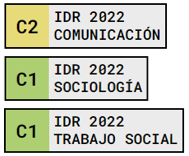

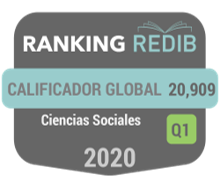
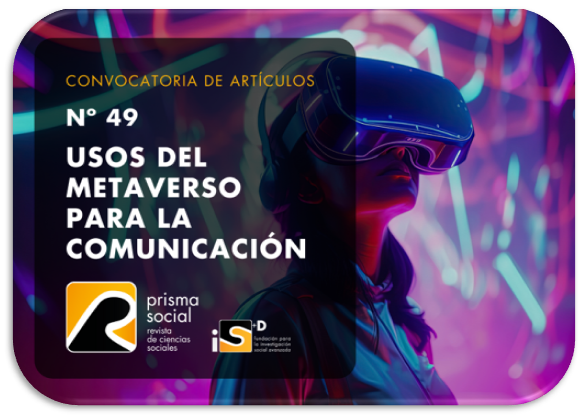
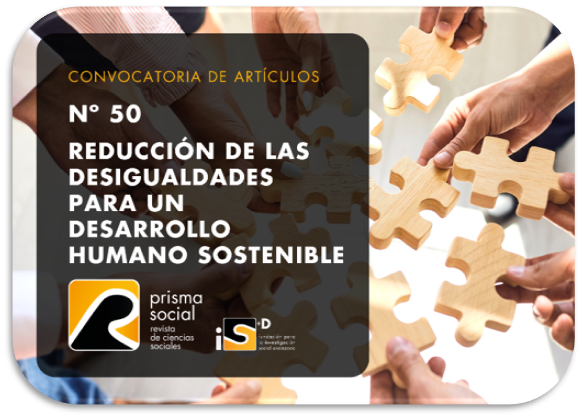








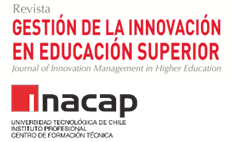



.png)




